Raffaele Frumenti
| Raffaele Frumenti | |
|---|---|
 Raffaele Frumenti in the 1970s | |
| Born |
1 September 1922 Rome, Italy |
| Died |
29 January 2002 (aged 79) Rome, Italy |
| Nationality | Italian |
| Education | Scuola romana |
| Known for | Painting |
| Notable work |
Diaconi (Deacons) |
| Movement | Contemporary |
| Awards |
|
Raffaele Frumenti (born 1 September 1922), was an Italian painter belonging to the modern movement of the Scuola romana (Roman School).[1]
Life and career
Born in the ancient Roman papal suburb of Borgo Pio, painter by vocation, Frumenti exhibited artistic and expressive ability since his boyhood, when for pure fun he used to build some small marionette theatres (subsequently to appear in his works), taking care of set and scenography. Married to Dorotea Savasta in 1943, after the end of World War II he alternated painting with many other jobs. In this period, which he called the yellow phase, his artistic production was deeply influenced by his staying in Sicily[2]
In his next phase and after 1955, Frumenti painted subjects that, together with a renewed chromatic sense, were to define his final and decisive artistic mode: he represented characters resembling cardinals, who at the same time trigger vibrant images of clowns, in a world of ghosts projected from the subconscious, possibly the consequence of a childhood passed in seeking mysterious things inside the St. Peter's Basilica.[3]
His palette became brighter, acquiring strong colours of red hues, oranges, teals and chrome yellows - as preferred by Italian artists such as Giovanni Omiccioli,[4] Alberto Ziveri,[5] Purificato, Capogrossi, Eliano Fantuzzi,[6] Sante Monachesi and others who shared and admired Frumenti's style, also fusing together those experiences that designated the Roman School.
Frumenti was a teacher of Art Drawing in Rome's high schools[7] He was also commissioned by the Italian Art Trust to paint a triptych mural in the Hall of the San Basilio Academy of Rome.
Frumenti's world is an intensely coloured one, melancholy, ironic and captivating, which explodes in its representation of the human comedy.[8]
In 1991, on the occasion of Frumenti’s personal exhibition in Rome, Italian journalist Lino Longo (of Il Tempo) stated:
For me Raffaele Frumenti is a living monument, a man who’s given a splendid form to art, with his knowledge and wisdom, with the great love that animates him… His paintings have attracted me through the suffused tonality of their colours combined with the dramatic prominence of their figures, as a romantic veil that embraces without concealing.[9]
Exhibitions
(personal and collective)
- 1951 Rome - via Margutta "l° MOSTRA COLLETTIVA" 1952 Rome - via Margutta "l° MOSTRA FIERA" 1954 Roma - via Margutta "LA GIORNATA DI VIA MARGUTTA"
- 1955 Rome - Palazzo delle Esposizioni "Un fatto di cronaca"; Rome - via Margutta "III MOSTRA FIERA"
- 1956 Rome - via Margutta "MOSTRA DI PITTURA E SCULTURA DEI SOCI CULTORI" - Città di Castello Unione Arti Grafiche
- 1957 Rome - via Margutta "MOSTRA Di PITTURA E SCULTURA DEI SOCI CULTORI"; Rome - via Margutta "IV Mostra Fiera"
- 1958 Rome - via Margutta "IX FIERA D'ARTE"
- 1959 Rome - Galleria Marguttissima "SALONE D'INVERNO DELLA PITTURA ROMANA"
- 1960 Rome - 1° CONCORSO MOSTRA NAZIONALE PITTURA ESTEMPORANEA PREMIO MUGELLO 1960 - via Margutta "OMAGGIO DI VIA MARGUTTA ALLA XVII OLIMPIADE"; Borgo San Lorenzo "MOSTRA NAZIONALE DI PITTURA ESTEMPORANEA"; Rome- Palazzo delle Esposizioni "TI PREMIO DI PITTURA ESTEMPORANEA" Rome - Circolo Sabino "INCONTRI D'ARTE"
- 1962 Rome - Villa Borghese "MOSTRA VIAGGIANTE DI RITRATTISTI ITALIANI CONTEMPORANEI"
- 1963 Bari - CIRCOLO DELLA VELA; New York - GALLERIA FRANKEL'S; Lucca - GALLERIA G. GIORDANO
- 1964 Rome - Colle Oppio "III° FIERA D'ARTE" "GEMELLAGGIO ARTISTICO" Rome - Parigi; Lago d'Iseo 1969 MOSTRA D'ARTI FIGURATIVE 110 PREMIO "PILZONE" CENTRO TURISMO Olivella
- 1965 Rome - l° MANIFESTAZIONE D'AUTUNNO DEGLI ARTISTI MARGUTTIANI
- 1966 Rome - via Veneto "I° PREMIO INTERNAZIONALE DI PITTURA ESTEMPORANEA"; Rome - Palazzo delle Esposizioni "III° MOSTRA D'ARTE ORGANIZZATA DALLA M.A.CE.M.; New York - Galleria Frankel's; Rome - Colle Oppio "V° FIERA D'ARTE"; Verona - Palazzo Gran Guardia "III° MOSTRA INTERNAZIONALE D'ARTE MODERNA" I° PREMIO SUGLI "ASPETTI DEL NATALE ROMANO" CENTRO GIORNALISTICO V. COLONNA I° PREMIO "ASPETTI DEL NATALE DI ROMA"
- 1967 New York - Galleria Frankel's; Rome - via Giraud "I° TROFEO DI PITTURA E SCULTURA"; Roma - PALAZZO DELLE ESPOSIZIONI "SETTEMBRE ROMANO"; Roma - via Margutta "XIX° Fiera d'Arte". PALAZZO DELLE ESPOSIZIONI DI ROMA "CONCORSO METROPOLIS FILM" inaugurato dal Ministro Andreotti Roma - GALLERIA COMUNALE Roma - I° RASSEGNA D'ARTE CONTEMPORANEA (LUPA CAPITOLINA)
- 1968 Rome - GALLERIA TRITONE AL NAZARENO "Mostra Personale"; New York - GALLERIA FRANKEL'S; Roma - GALLERIA COMUNALE D'ARTE MODERNA "VI° BIENNALE ROMANA"; Roma - via Margutta "XX° FIERA D'ARTE; Roma - Palazzo Valentini "I° MOSTRA DI PITTURA CONTEMPORANEA"; Bari CIRCOLO RICREATIVO ENEL "l° MOSTRA DI PITTURA CONTEMPORANEA"; Rome - PALAZZO DELLE ESPOSIZIONI "Gemellaggio Roma-Napoli"; I° MOSTRA D'ARTE STEFER PREMIO VIAREGGIO "IL PANE DEI CARCAMANO"
- 1969 Bari - CIRCOLO DELLA VELA "Mostra Personale"; Roma - GALLERIA VECCHIA PINETA "Mostra Personale";Campobasso - GALLERTA KRISTIANIA Rome "SALONE KRISTTANIA" organizzazione de "Il Poliedro" Albano Laziale - RASSEGNA DI ARTI FIGURATIVE
- 1970 Rome - GALLERIA MICHELANGELO "Mostra Peronale"; Roma - GALLERIA VECCHIA PINETA "Mostra personale"; Roma - via Margutta "XXII° FIERA D'ARTE" Ostia Lido - III° RASSEGNA D'ARTE LIDENSE "PREMIO TIBIDABO D'ORO" XXVI° FIERA D'ARTE di via Margutta RASSEGNA NAZIONALE DI ARTI FIGURATIVE "ACCADEMIA LA FUCINA"
- 1971 Campione d'Italia - "VIA MARGUTTA A CAMPIONE - MOSTRA D'ARTE CONTEMPORANEA"; Rome - GALLERIA IL CAPRICORNO "Mostra Personale"
- 1972 Rome - GALLERIA IL CAPRICORNO "Mostra Personale"
- 1973 Rome - via Margutta "IL MARGUTTONE" - patrocinato dal Comune di Roma
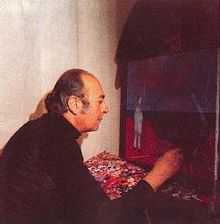
- 1974 Rome - GALLERIA IL CAPRICORNO "Mostra personale" - Rome PALAZZO MARGUTTA - Rome TARTAGLIA ARTE - Sezione speciale opere d'arte
- 1975 Rome - PALAZZO DELLE ESPOSIZIONI "X Quadriennale d'Arte"
- 1976 Rome - GALLERIA ALPHA CENTAURI; Roma - GALLERIA LA FALENA; Roma - GALLERIA "IL CAPRICORNO" mostra personale.
- 1979 Rome - GALLERIA "IL CAPRICORNO" mostra personale I° EDIZIONE PREMIO "Il Muretto" Alassio un fatto di cronaca - PALAZZO DELLE ESPOSIZIONI XXI° MOSTRA D'ARTE di via Margutta
- 1980 Roma - GALLERIA LO SCORPIONE "Mostra Personale"; Roma - GALLERIA ITALIANA D'ARTE MODERNA "Mostra Personale"; Roma - GALLERIA BALDUINA "Mostra Personale"; Roma - GALLERIA PALAZZO MARGUTTA "Mostra Personale"
- 1982 Rome - GALLERIA IL CAPRICORNO "Mostra Personale"
- 1983 Firenze - GALLERIA INTERNAZIONALE GAI Via Tornabuoni - Roma TARTAGLIA ARTE GALLERIA "NOCCHIA" Civitavecchia Roma - GALLERIA DI MARCO - Germania, Gladbeck -"Art Fontana Erika"; Napoli - ART GALLERY "De Gregorio"; Taranto - GALLERIA D'ARTE "Del Core"
- 1984 Rome - GALLERIA IL CAPRICORNO "Mostra Personale"; Viterbo - GALLERIA CONTEMPORANEA d'Arte M. Nocchia - Reggio Calabria "Arte Oggi" Palermo GALLERIA D'ARTE CONTEMPORANEA "Florentia"
- 1985 Civitavecchia - GALLERIA LA PACE; Rome - TARTAGLIA ARTE "Arte oggi"; Reggio Calabria GALLERIA D'ARTE; Reggio Calabria - GALLERIA D'ARTE PIANCARANI; Teramo- GALLERIA DI OTTAVIO
- 1986 Rome - GALLERIA IL CAPRICORNO "Mostra Personale"; Viterbo - GALLERIA S. LORENZO Rome TARTAGLIA ARTE "Sezione Speciale opere d'Arte"; Padova - EURODARTE DE RITA
- 1988 Bari - GALLERIA MODERNA BARBONE; Cosenza - GALLERIA D'ARTE CONTEMPORANEA Le Gardin de l'Arte Roges di Remde; Rome - GALLERIA TUSCOLANA "Tartaglia Arte"; Santa Maria a Vico (CE) - CENTRO D'ARTE "Il Cuneo"; Messina - GALLERIA PRESTIPINO
- 1989 Viterbo - GALLERIA D'ARTE S. LORENZO; Cosenza - GALLERIA D'ARTE CONTEMPORANEA Le Gardin (le l'Arte Roges di Remde); Roma - TARTAGLIA ARTE SEZIONE SPECIALE OPERE D'ARTE; Palermo "Galleria d'Arte Florentia"; Cosenza - "L'incontro"
- 1990 Rome - CENTRO INTERNAZIONALE ARTISTI CONTEMPORANEI "Premio Primavera" - Patrocinato dal Comune di Roma; Roma - GALLERIA TARTAGLIA ARTE "Sezione speciale opere d'arte" CENTRO D'ARTE "Il Cuneo" Santa Maria a Vico (CE) - Palermo GALLERIA D'ARTE CONTEMPORANEA "Florentia" ARTE OGGi - Personale GALLERIA CORALLO - Bari; Crotone - "Il Cubo"; Torino - CENTRO D'ARTE VERNELLI
- 1991 Rome - Palazzo Valentini, Sala del Consiglio - PRESIDENZA DEL CONSIGLIO URPL (UNIONE REGIONALE DELLE PROVINCE DEL LAZIO) - Assessorati Cultura del Comune di Roma della Provincia di Roma e della Regione Lazio - Assessorato al Bilancio della Provincia di Roma - TARTAGLIA ARTE ROMA - Sezione Speciale Opere Arte
Notes
- ↑ Cf. biographical note on Monterossocalabro.com. Accessed 22/05/2011
- ↑ See for instance some of the titles for paintings of that period: Piazzetta del Sud (Southern Square) - Il ragazzo con il somarello (Boy with Donkey)- Le comari - Uomini di paese (Village Men) - Cantastorie (Storytellers). Predominant colours: gold ochres, maroons, deep greens and chalky whites. Cf. Biographical Notes.Accessed 22 May 2011
- ↑ Cf. information on Arte Nocchia. Accessed 22 May 2011
- ↑ Cf. it:Wiki under Giovanni Omiccioli, as well as Giovanni Omiccioli, biography
- ↑ Cf. Roman School, Alberto Ziveri and the Scuola romana, as well as it:Wiki under Alberto Ziveri
- ↑ Cf. Eliano Fantuzzi on Firenze Art. Accessed 22 May 2011
- ↑ Specifically at the Scuola Media Statale Benvenuto Cellini.
- ↑ Artist's interview on YouTube
- ↑ Cf. Raffaele Frumenti. La Commedia Umana (Raffaele Frumenti. The Human Comedy), Rome 1991, p.25.
Gallery of works
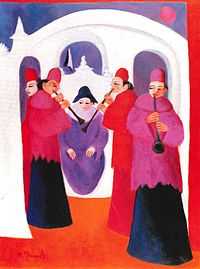 Suonatori (Players, 1963) 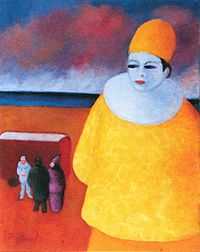 In giallo (In yellow, 972) |
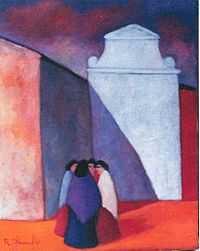 Donne romane (Roman women, 1977) 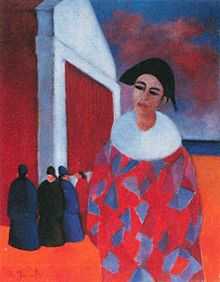 Arlecchino (Arlequin, 1979) |
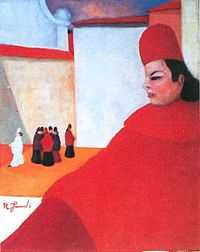 Prelato in rosso (Prelate in red, 1984) 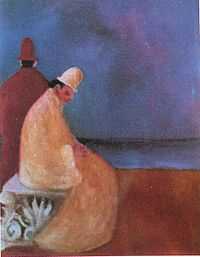 Intervallo d'attori (Actors' break, 1991) |
See also
Bibliography
- Various Authors, Raffaele Frumenti. La Commedia Umana (Raffaele Frumenti. The Human Comedy), Tartaglia Arte, Rome 1991.
- Comune di Roma, Catalogo Biennale di Roma: Monografia "Il Maestro", Mondadori Art.
External links
- (Italian) Artist's Note, on Tartaglia Arte. Accessed 22 May 2011
- (Italian) Biographical Information, on Monterossocalabro.com. Accessed 22 May 2011
- (English) Raffaele Frumenti, on Arcadja.com. Accessed 22 May 2011
- Video on YouTube, video interview of Frumenti in his studio (uploaded 27 August 2007)
| ||||||||||||||||||||||||||